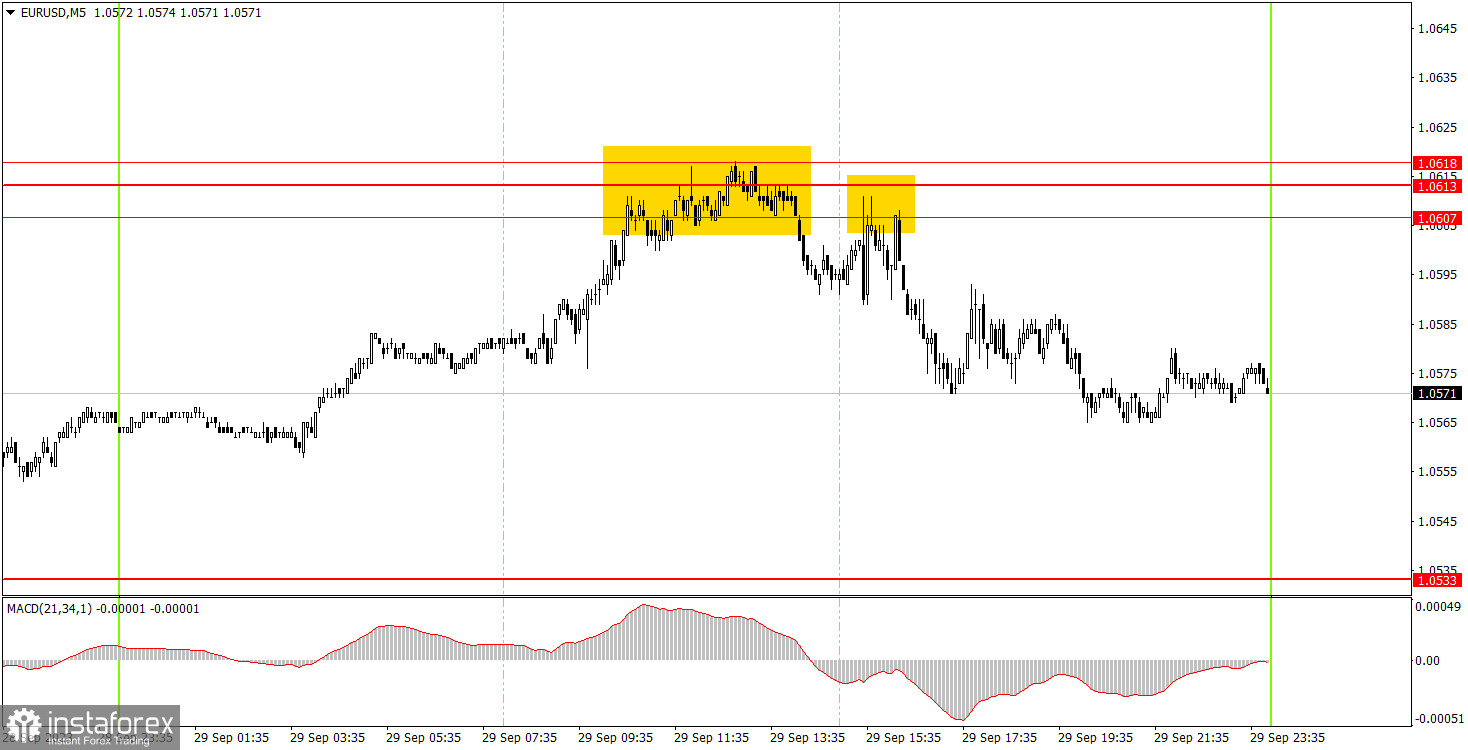Analyzing Friday's trades:
EUR/USD on 30M chart

EUR/USD continued to trade higher on Friday, as anticipated. There was a good amount of economic data on Friday, but there were few genuinely significant reports. The eurozone inflation report was in the spotlight. However, there is no longer a correlation between inflation and interest rates in Europe, as the European Central Bank has made it clear that any further tightening of monetary policy would only happen in the event of a major unforeseen event. Therefore, regardless whether inflation rises or drops, it no longer holds much weight for both the euro and the ECB's interest rates.
Once the pair reached the level of 1.0613, it rebounded and the euro fell, which, once again, was not related to macroeconomics or fundamentals. ECB President Christine Lagarde did not touch upon monetary policy in her speech. U.S. data were fairly neutral. Therefore, we believe that the pair corrected higher due to technical reasons, and then it edged down for the same reasons.
EUR/USD on 5M chart

Two decent trading signals were formed on the 5-minute chart. Both times, the price bounced off the area of 1.0607-1.0613-1.0618. In the first case, it only managed to fall by 10 pips, so traders should have stayed in short positions by the time the second signal was formed. During the U.S. session, the downward movement was more interesting, and beginners could have earned about 20 pips. However, don't forget about the low volatility. If we don't count the Asian trading session, volatility was 52 pips on Friday.
Trading tips on Monday:
On the 30-minute chart, EURUSD started to correct higher. In the medium term, we anticipate the euro's further decline, but in the next few days or even a week, the pair may start an upward movement. Just like it did for the last two days, it can move without any specific reasons behind it. The key levels on the 5M chart are 1.0391, 1.0433, 1.0465, 1.0517-1.0533, 1.0607-1.0613-1.0618, 1.0673, 1,0733, 1,0767-1,0781, 1,0835. A stop loss can be set at a breakeven point as soon as the price moves 15 pips in the right direction. On Monday, Manufacturing PMIs will be published in the EU and the United States, but you should focus on the US ISM index. Also, Federal Reserve Chairman Jerome Powell is scheduled to speak, but it will be held overnight, so it won't have an impact on daytime movements.
Basic trading rules:
1) The strength of the signal depends on the time period during which the signal was formed (a rebound or a break). The shorter this period, the stronger the signal.
2) If two or more trades were opened at some level following false signals, i.e. those signals that did not lead the price to Take Profit level or the nearest target levels, then any consequent signals near this level should be ignored.
3) During the flat trend, any currency pair may form a lot of false signals or do not produce any signals at all. In any case, the flat trend is not the best condition for trading.
4) Trades are opened in the time period between the beginning of the European session and until the middle of the American one when all deals should be closed manually.
5) We can pay attention to the MACD signals in the 30M time frame only if there is good volatility and a definite trend confirmed by a trend line or a trend channel.
6) If two key levels are too close to each other (about 5-15 pips), then this is a support or resistance area.
How to read charts:
Support and Resistance price levels can serve as targets when buying or selling. You can place Take Profit levels near them.
Red lines are channels or trend lines that display the current trend and show which direction is better to trade.
MACD indicator (14,22,3) is a histogram and a signal line showing when it is better to enter the market when they cross. This indicator is better to be used in combination with trend channels or trend lines.
Important speeches and reports that are always reflected in the economic calendars can greatly influence the movement of a currency pair. Therefore, during such events, it is recommended to trade as carefully as possible or exit the market in order to avoid a sharp price reversal against the previous movement.
Beginners should remember that every trade cannot be profitable. The development of a reliable strategy and money management are the key to success in trading over a long period of time.
 English
English 
 Русский
Русский Bahasa Indonesia
Bahasa Indonesia Bahasa Malay
Bahasa Malay ไทย
ไทย Español
Español Deutsch
Deutsch Български
Български Français
Français Tiếng Việt
Tiếng Việt 中文
中文 বাংলা
বাংলা हिन्दी
हिन्दी Čeština
Čeština Українська
Українська Română
Română

